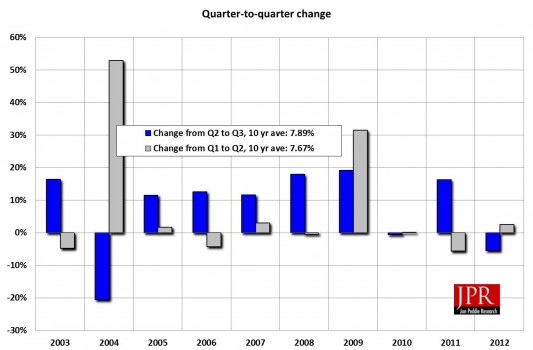Third quarter results from Jon Peddie Research show Nvidia gaining in both desktop and notebook graphics.
Nvidia saw its share of the graphics chip market rise during the third quarter of 2012 at the expense of rivals AMD and Intel. But the victory is not completely encouraging—the total market shrank compared to a year ago and last quarter. Market results are being published today by Jon Peddie Research.

The news was terrific for Nvidia and disappointing for the other major players. From Q2 to Q3 Intel slipped in both desktop (7%) and notebook (8.6%). AMD dropped (2%) in desktop graphics, and (17%) in notebooks. Nvidia gained 28.3% in desktop from quarter to quarter and jumped almost 12% in the notebook segment.
Shipments were down -1.45% on a quarter-to-quarter (sequential) basis, and -10.8% on a year-over-year basis. JPR says graphics shipments during 3Q12 slipped from last quarter -1.5% as compared to PCs which grew slightly by 0.9% overall. (More GPUs shipped than PCs due to workstations with dual GPU installs.)
GPUs are traditionally a leading indicator of the market, since a GPU goes into every system before it is shipped. Most PC vendors are saying they expect sales to be down in the fourth quarter.

Because of the current turmoil in the PC market, Jon Peddie Research is modifying its forecast, turning less aggressive on both desktops and notebooks. The popularity of tablets and the persistent recession are the contributing factors that have altered the nature of the PC market. Nonetheless, the compound annual growth rate (CAGR) for PC graphics from 2011 to 2016 is expected to be 3.6%; JPR says total shipments of graphics chips in 2016 should be 608 million units.
The ten-year average change for this quarter is a growth of 7.9%. This quarter is below the average with a 5.5% decrease.
JPR findings include discrete and integrated graphics (CPU and chipset) for Desktops, Notebooks (and Netbooks), and PC-based commercial (i.e., POS) and industrial/scientific and embedded. This report does not include handhelds (i.e., mobile phones), x86 Servers or ARM-based Tablets (i.e. iPad and Android-based Tablets), Smartbooks, or ARM-based Servers. It does include x86-based tablets.





